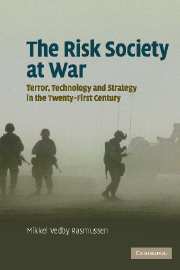Book contents
3 - Technology: the revolution in military affairs
Published online by Cambridge University Press: 22 September 2009
Summary
One day in the autumn of 2001, a Predator drone flew above the mountains of Afghanistan, gathering intelligence on the operation of US special forces below. The Predator is an Unmanned Aerial Vehicle (UAV) piloted by specialists from well behind the front line, but back in Washington the President was following the live feed from the Predator, which gave him as much information as if he had been flying a reconnaissance plane above Afghanistan, and certainly better than what was available to the soldiers on the ground below. Had the Predator been of the new version equipped with Hell-Fire missiles, which the US armed forces were introducing in the Afghanistan campaign, then the Commander-in-Chief could have taken part in the battle himself by remote control. George Bush's Predator experience was probably mostly a gimmick set up to illustrate the power of the new military technologies to the President, but in the near future he will immediately be able to plug into any US military operation by means of the so-called Global Information Grid, a US military network linking all platforms at all times. This is an example of how information and communication technology is fundamentally changing the technological aspects of strategy, a transformation that is often referred to as a ‘revolution in military affairs’, or RMA for connoisseurs of military acronyms.
- Type
- Chapter
- Information
- The Risk Society at WarTerror, Technology and Strategy in the Twenty-First Century, pp. 43 - 90Publisher: Cambridge University PressPrint publication year: 2006

